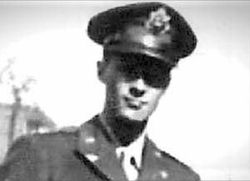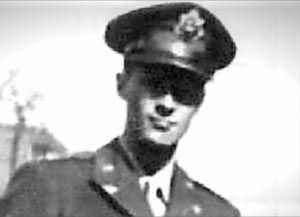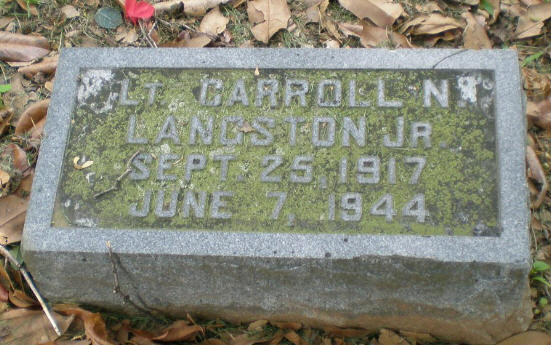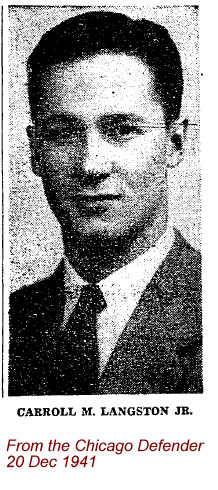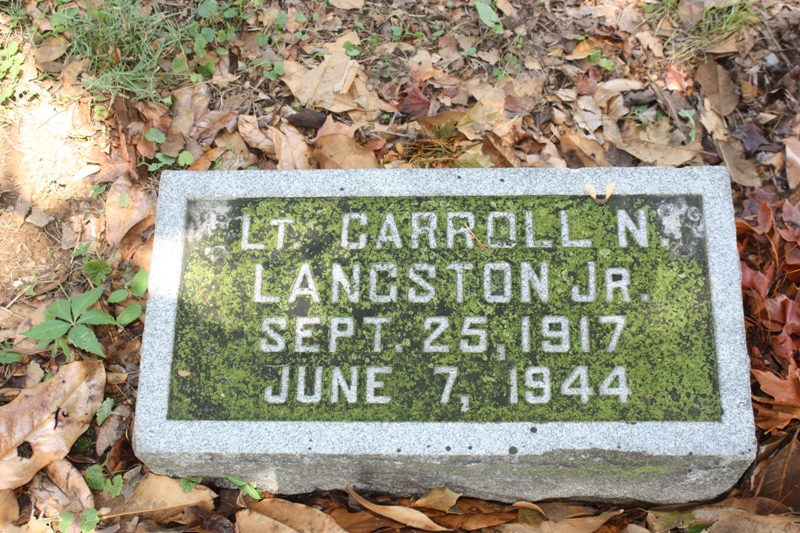September 25, 1917 – June 7, 1944
Class: 43-I-SE
Graduation Date: October 1, 1943
Graduation Rank: 2d Lt
Unit: 332nd Fighter Group, 301st Fighter Squadron
Service # O-814197
Carroll was an only child, born in 1917 to Carroll N Langston and Vivien Cashin in Nashville. When he was young, his parents moved to Chicago, where Carroll attended primary school. He graduated from Hyde Park High School in 1934, and from Oberlin College in 1938, where he lettered on the baseball team. His major was French. Carroll went on to attend the University of Michigan, where he earned a degree in law. In 1941, he joined a law practice in Chicago, but within short time he enrolled in the Tuskegee Army Air Field in Alabama, being one of the first cadets to graduate. He completed his training Oct 2, 1943 and was assigned to the 301st Fighter Squadron, 332nd Fighter Group. He was sent to Italy in January of 1944.
On June 7, 1944, Tuskegee Airman Lt. Carroll Napier Langston Jr. gave the ultimate sacrifice after his P47-D aircraft lost oil pressure while his squadron completed a World War II strike mission.
There were witnesses to the incident — Lts. Maurice V. Easters, Ulysses S. Taylor, and Harold E. Sawyer. Lt. Sawyer reported that Carroll called in saying that he had engine trouble. Carroll was unable to keep up in flight, so Saywer left his route to fly with Carroll. Carroll was not able to keep the plane up, so decided to bail out, but something went wrong with his chute. It did not inflate all the way and Sawyer saw Carroll hanging on to the side of the plane. Sawyer could not stay with him because of low fuel, but notified Air Rescue. Carroll's plane crashed about 10 miles off the coast of San Benedetti, Italy. The paperwork even includes a hand-drawn map of where his plane went down.
A report from September 19, 1944 provides an account from the person that found his body, Captain Samuel R. Center. While he was on reconnaissance with 5 others, he found a body that had washed up to the beach of the Adriatic Sea near Pineta, Italy on June 26, 1944. Langston's body, with gunshot wounds to the head and chest, was found 19 days later washed ashore near Pineta, Italy. The account describes everything that they found on his body, information about how they buried him and a detailed description of where they buried him. On his person were items such as his ID tags, his pilot wings, a metal cigarette case, and his watch. They buried him "…about 750 feet south of railroad flag station no. 331, 200 feet from railroad track towards sea; 65 feet towards sea from second concrete post of barbed wire fence.
His body and personal effects were wrapped in a mattress cover and laid to rest in a shallow grave, with his identification tags and name written on a wooden cross that marked the site.
His remains were exhumed and re-interred in a nearby cemetery and later re-interred again in Bari Military Cemetery in Italy.
His parents, Carroll Napier Langston Sr. and Vivian Langston, sought to have their son's body brought home for a permanent resting place. Four and a half years later that finally occurred, with his body buried in Greenwood Cemetery, in Nashville, Tennessee.
One final step remained incomplete: Langston never had a full military burial.
Tom McKnight has come to learn that story while researching his family tree. McKnight, a member of the color guard for the American Legion Post 31 in Tuscumbia, is a cousin of the fallen lieutenant.
"Quite a journey, wasn't it?" McKnight asks, while going over the long trek of his cousin's remains. "Can you imagine the anguish of his parents? Four and a half years."
Still, McKnight and his fellow color guard members realize one final step remains incomplete:
Langston never had a full military burial.
On June 10, 2017 that changed. The guard is traveling to Langston's gravesite to perform the procedure, including a rifle volley, folding of an American flag and playing of "Taps."
McKnight spent years tracing his cousin's history. Langston applied to become a Navy pilot but was denied because of his race, so he became a Tuskegee Airman. Click here to watch the ceremony.
His was among 36 aircraft on the June 7, 1944, sweep mission, and the only one that never returned.
Sources:
Black Nashville Genealogy & History
HonorStates.org
Times Daily
WikiTree.com
September 25, 1917 – June 7, 1944
Class: 43-I-SE
Graduation Date: October 1, 1943
Graduation Rank: 2d Lt
Unit: 332nd Fighter Group, 301st Fighter Squadron
Service # O-814197
Carroll was an only child, born in 1917 to Carroll N Langston and Vivien Cashin in Nashville. When he was young, his parents moved to Chicago, where Carroll attended primary school. He graduated from Hyde Park High School in 1934, and from Oberlin College in 1938, where he lettered on the baseball team. His major was French. Carroll went on to attend the University of Michigan, where he earned a degree in law. In 1941, he joined a law practice in Chicago, but within short time he enrolled in the Tuskegee Army Air Field in Alabama, being one of the first cadets to graduate. He completed his training Oct 2, 1943 and was assigned to the 301st Fighter Squadron, 332nd Fighter Group. He was sent to Italy in January of 1944.
On June 7, 1944, Tuskegee Airman Lt. Carroll Napier Langston Jr. gave the ultimate sacrifice after his P47-D aircraft lost oil pressure while his squadron completed a World War II strike mission.
There were witnesses to the incident — Lts. Maurice V. Easters, Ulysses S. Taylor, and Harold E. Sawyer. Lt. Sawyer reported that Carroll called in saying that he had engine trouble. Carroll was unable to keep up in flight, so Saywer left his route to fly with Carroll. Carroll was not able to keep the plane up, so decided to bail out, but something went wrong with his chute. It did not inflate all the way and Sawyer saw Carroll hanging on to the side of the plane. Sawyer could not stay with him because of low fuel, but notified Air Rescue. Carroll's plane crashed about 10 miles off the coast of San Benedetti, Italy. The paperwork even includes a hand-drawn map of where his plane went down.
A report from September 19, 1944 provides an account from the person that found his body, Captain Samuel R. Center. While he was on reconnaissance with 5 others, he found a body that had washed up to the beach of the Adriatic Sea near Pineta, Italy on June 26, 1944. Langston's body, with gunshot wounds to the head and chest, was found 19 days later washed ashore near Pineta, Italy. The account describes everything that they found on his body, information about how they buried him and a detailed description of where they buried him. On his person were items such as his ID tags, his pilot wings, a metal cigarette case, and his watch. They buried him "…about 750 feet south of railroad flag station no. 331, 200 feet from railroad track towards sea; 65 feet towards sea from second concrete post of barbed wire fence.
His body and personal effects were wrapped in a mattress cover and laid to rest in a shallow grave, with his identification tags and name written on a wooden cross that marked the site.
His remains were exhumed and re-interred in a nearby cemetery and later re-interred again in Bari Military Cemetery in Italy.
His parents, Carroll Napier Langston Sr. and Vivian Langston, sought to have their son's body brought home for a permanent resting place. Four and a half years later that finally occurred, with his body buried in Greenwood Cemetery, in Nashville, Tennessee.
One final step remained incomplete: Langston never had a full military burial.
Tom McKnight has come to learn that story while researching his family tree. McKnight, a member of the color guard for the American Legion Post 31 in Tuscumbia, is a cousin of the fallen lieutenant.
"Quite a journey, wasn't it?" McKnight asks, while going over the long trek of his cousin's remains. "Can you imagine the anguish of his parents? Four and a half years."
Still, McKnight and his fellow color guard members realize one final step remains incomplete:
Langston never had a full military burial.
On June 10, 2017 that changed. The guard is traveling to Langston's gravesite to perform the procedure, including a rifle volley, folding of an American flag and playing of "Taps."
McKnight spent years tracing his cousin's history. Langston applied to become a Navy pilot but was denied because of his race, so he became a Tuskegee Airman. Click here to watch the ceremony.
His was among 36 aircraft on the June 7, 1944, sweep mission, and the only one that never returned.
Sources:
Black Nashville Genealogy & History
HonorStates.org
Times Daily
WikiTree.com
Family Members
Sponsored by Ancestry
Advertisement
Advertisement
